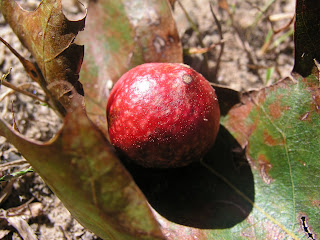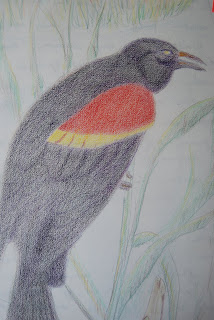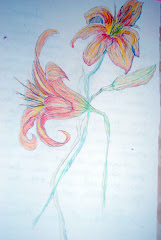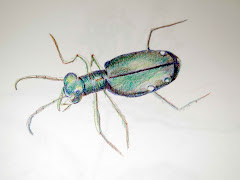


Sanctuary
8/5/08
I headed in an opposite direction than usual today. A local farmer had sprayed the fields bordering the creek, using an atomized method; this renders a spray so fine, that it seeps into even closed windows, and creates a noxious and suffocating fume. The smell was oppressive, much more intense and unpleasant than fertilizer of days gone by, so though I tried, at first, to ignore it, I quickly realized that it would not do, and turned the boat eastward, upwind.
Problem is, the brook affords a lot of shade, and privacy, which I was seeking today, and so I wasn’t thrilled about heading out into the hot, open creek, with little protection from the sun. But I hadn’t gone a ½ mile when I noticed a little leafy edge, up against the hill on the eastern bank. Hanging from the side of the embankment there was an alder, with branches so low, that some were hanging in the water. This created a small blockage of the current where the water eddies and swirls as it goes past a fallen limb in the creek; a slight whirlpool is here created in its wake. Behind this blockage, and under this shade, was created a minute paradise, free of noise, or traffic, or noxious smell!
Ironically, most of the shade was provided by a white oak, just like the one that I was originally headed for; like the one whose shade I love to nestle under in the brook, so I was quite pleased to find it. Of course, this was a much younger one, with
not nearly the circumference of shade, nor nowhere near the splendor or presence of “my” oak, but it was leafy, and tall, about 15 feet - probably about ten years old. Next to it was a birch, about the same age, and next to that was a sumac, much younger, but because they grow so fast, and their compound leaves spread wide, they give a good amount of shade, early on. Together, they provided very decent cover, in fact, it was absolutely enticing: a leafy little sanctuary, complete with chipping sparrows.
On the steep embankment, above my head, rose Virginia creeper, sorrel, plantain, and mullein. In addition, the bank was covered with lichen and moss. The sandy hillside was covered with tunnel-like holes, like diminutive versions of the nest-tunnels created by belted kingfishers. In addition, there were many types of fungi: a diminutive black mushroom that looked like an umbrella; a little disk-shaped white mushroom about the size of a sunflower seed; and small cup-shaped projections that stood at attention like so many minute soldiers, each ½ the height of a straight pin.
Because the hill was sandy, it eroded easily, and the fine, filamental roots of the grasses were exposed, creating a fine network through the soil, and upon that, some species of spider had spun his web, again and again, and these were now covered with a fine spray of sand, creating a diaphanous curtain, that spread across the bank. I lightly touched one, here and there, careful to do no damage, in hopes that the architect would show up to investigate the disturbance, but my efforts were not rewarded.
I did notice that many of the fine holes in the bank were covered with this webbing, each with a distinct round opening in the middle of the web; an opening, coinciding with the center of the hole it covered. Was this the door to his cave? Was this his tunnel with the very center left open so that he could move about unhindered by his sticky lair?
As I looked at a patch of common carpet moss (mnium) mixed in with some broom moss (dicranum) I noticed a small slug, looking for all the world like a miniature Loch Ness monster, its antennae, little stubs; its body glistening in the sun. It sat motionless until I touched it with my pen, and then it moved only slightly.
As I sat here, a young rabbit moved across my view of the bank, stopping just six feet away to nibble the grass. As he moved unconcernedly up the hill he flashed his white cottontail and disappeared over the ridge.
So much to see in such a small space! I am here reminded of the incredible diversity of life, and how rich a few square yards can be. I set out today tired and cross, resentful that my usual sanctuary had been sullied, but in the span of ten minutes, I found yet another sanctuary, a world unto itself. As I looked at these fascinating and beautiful living things, my heart rate began to slow, my breathing became deeper, and I began to forget about my troubles; I could only glory in the gifts that surrounded me. I head home now more patient, more hopeful, and kinder than I left. Perhaps there is a finer way to spend an hour, but I cannot think what that might be.





















